
16 minute read
WINTER TRIATHLON
THE 2004 WINTERLUDE TRIATHLON
By Rick Hellard
Advertisement
“Skaters. Take your mark. GO!”
Imagine 500 blades flashing, clacking and gliding along Dows Lake and funnelling into the Rideau Canal. At 35 kilometres per hour. A bit intimidating perhaps, but really cool to see.
The lead pack forms quickly with one skater hammering up front and the rest falling in behind for the tow. The wicked pace separates those who possess turbo-diesel engines for hearts and lungs. Slowly, the lead group is whittled down to 20 by the end of the skate.
Blowing vast plumes of hot vapour into dry air, participants rush to metamorphose from speed skater to cross-country skier. They change footwear in a flash and push off hard into the stiff wind on the challenging ski course. Arms, legs, poles and skis flail in controlled chaos as the best skiers put distance between themselves and the pack. Before long, the triathlon course is festooned with great skiers whose skating is not their strong point—great skaters whose skiing leaves something to be desired, and all who lie in between. It is exhausting, humbling and great fun.
Before the last skaters are even off the ice, the front skiers are already in transition for the final event—running. Burning, uncooperative thighs and calves propel the skiers-nowturned-runners as the blood changes course toward the running muscles.
By now the frontrunner’s lungs are searing in the winter air. The running portion is the final test to sort out who wants victory most. It’s often the great equalizer—either you can run faster than the people around you, or you can’t. All that fancy equipment and agonizing over the proper waxing technique is in the rear-view mirror.
Unlike the first two events, people tend not to fall when they run. They don’t get tangled up with other runners. This is the final push to the finish, so everyone fights to either catch and pass, or not get caught and passed.
Once across the finish line, everyone catches their breath and laughs about everything that happened during yet another Winterlude Triathlon.
Meanwhile, skiers continue to finish up their stint on the “misery sticks” and head out on the running portion of the course to finish their race. Many of them are thinking, dollars to minutes, they’re getting better value than those who are already finished—and they have a point!
This staple event of the National Capital Commission’s Winterlude consists of an 8-km skate along the Rideau Canal, a 7-km cross-country ski through the Dominion Arboretum and a 5-km run along a new-in-2004 running course—the snow-packed side of the Rideau Canal.
As Race Director and a long-time participant, I offer a few suggestions to prepare for this great winter activity.
First and foremost, don’t be intimidated by the distances or the speeds. This event is suited to everyone from the fast and furious to the “weekend warrior.”
Secondly, treat it as a goal that will help you maintain or improve
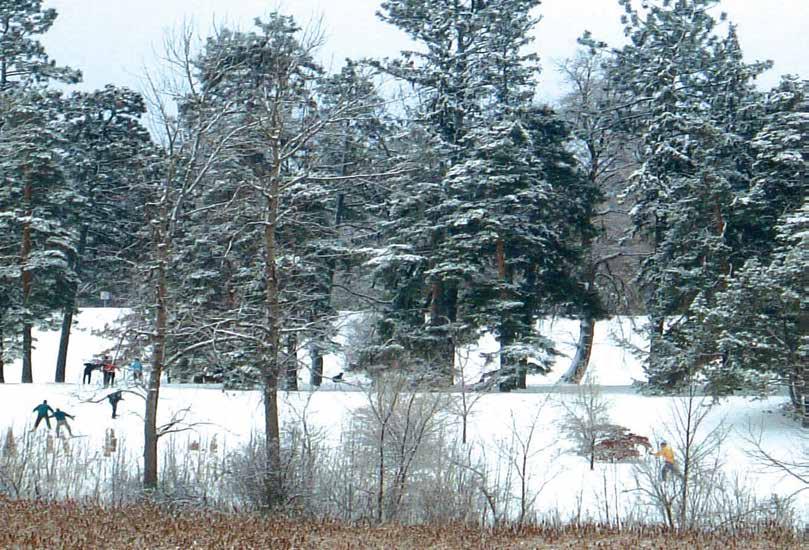
your fitness over the winter. If you do, it’ll help motivate you to get outdoors on those not-so-beautiful days between now and February.
If you plan to participate in the 2004 Winterlude Triathlon, here are a few simple guidelines and mid-term goals that may prove helpful.
RACE DAY
1. Arrive early so you can get ready in a relaxed setting. 2. Dress for the weather, bearing in mind you will be working hard during the race. 3. Wear warm clothes before and dry, warm clothing afterwards. Change quickly after the race to avoid getting chilled. 4. Make sure to warm up on the ski course, then the skate. Warming up on skis will let you know if you nailed the wax of the day or not. It will also give you a chance to preview the ski course so you know where you’re going. Warming up on the skate last allows you to head straight for the starting line without changing footwear. 5. Have fun. This race is a blast and opens the door for levity and good health.
THE SKATE
1. Don’t learn to skate a week before the race. 2. To better enjoy the experience, you should be comfortable skating 15 kilome tres. This will ensure you have enough of an energy reserve for the rest of the race. 3. You don’t need clip-on blades, but
they do help a great deal for speed, comfort and ease of transition. They are available from most local cross-country ski retailers. 4. Skating hunched over for 10 to 20 minutes can be tough on the lower back; do some abdominal and lower back exercises to prepare. 5. On race day, treat the skate like a bike race—be prepared for a very fast start. The first couple of minutes are ballistic, but it will settle down to just plain fast.
THE SKI
1. Don’t learn to ski a week before the race. 2. You can use either the skate or diagonal stride technique. Skate skiing is generally faster and recommended. 3. You should be comfortable skiing 15 kilometres. Again, this will ensure you have enough energy to ski well after the skate with energy to spare for the run. 4. Practice skiing in tight conditions with lots of twists and turns on crowded (but friendly) trails. 5. Use the first couple of minutes to establish your “ski legs” and balance, then pick it up. athletic shoe retailers. Trying to tie your shoes with cold hands in a hurry doesn’t work very well. 3. Expect your legs to feel “off-full” after the ski—they’ve gone from smooth gliding in the skate and ski events to thumping the frozen ground. Use the first two minutes or so to get your “running legs,” then pick up the pace as you feel better.
The 2004 Winterlude Triathlon— sponsord by Bushtukah Great Outdoor Gear—is scheduled for Saturday, February 7. For more information, please visit www.Zone3sports.com or drop by local retailers for an entry form.
—Rick Hellard has been competing in running, cycling, triathlon and cross-country ski races for more than 21 years. The owner of Zone3sports: Multi-Sport Training Programs, he is also a snowshoe racer, undefeated in three years. Hmmm, is that a challenge Rick? :)
a winter rush?
Dogsledding in Wakefield of course
IF YOU’RE LOOKING for a new experience in the great outdoors of this Ottawa region, then you’ve got to get out and give dog-sledding a go.
“This was the most fun day of my life.”
The quotation above was just one of a bunch of testimonials we found on their website. Our own staff writer went last winter and she hasn’t come down yet.
Give James a call and he’ll tell you all you need to know. Have fun! Here’s their contact info: Expéditions Radisson www.ExpeditionsRadisson.ca Toll Free 1-888-459-3860
THE RUN
1. Make sure you can run a minimum of eight kilometres fairly comfortably to ensure you have enough left in the tank for the run portion. 2. Use lace locks and/or elastic laces in your running shoes—available from most

HEALTH
exercise
By Dr. Geoff Outerbridge, M.Sc., D.C.
OUTDOOR enthusiasts living in Ottawa are twice blessed— they’re doing something they love and they enjoy the health benefits that flow from physical activity.
Many people don’t understand, however, the complex relationship between exercise and their body. A surprisingly large percentage of outdoor enthusiasts still compromise their fitness by clinging to health myths.
We’ve all heard these common complaints: “I work on my abs all the time and I still have this gut,” or “I’m too old to start exercising,” or “Playing tennis hurt my shoulder, so I packed it in.”
Not only do such myths make it difficult to maximize the health benefits of your favourite activities, they prevent people from engaging in the activities they love. By understanding a few key concepts about how exercise affects your body, you can avoid these common misconceptions.
Here’s the basic concept to dispel most exercise myths: When your body is exposed to a physical stress, it slowly adapts so the next time it encounters the same stress, it’s better suited to deal with it.
We all understand that muscles will get bigger if we make them lift heavy loads. Our body will also adapt to physical stresses by increasing the density and diameter of bone, creating molecules that burn fat and
carbohydrates or make proteins, increasing the number of blood vessels to tissues, and so on. In order to build these molecules and tissues, the body needs the basic building blocks such as vitamins, minerals, carbohydrates, fats and proteins.
The adaptations the body generates are specific to the demands. If your exercise routine involves lifting heavy weights, your body will adapt for weight-lifting, but it won’t be ready to run a marathon.
Your physical demands must be within your body’s capacity to adapt and it has to have sufficient time to recover. If the demands are excessive, tissues will become damaged. This damage and subsequent repair is often sub-clinical (you don’t feel it) and bits of fibrous tissue will be left behind. These bits of tissue can accumulate over time, perhaps years, and eventually cause pain. The discomfort may be sudden, but the problem was probably building for a long time.
Let’s examine some common exercise fallacies:
1. I can use the same exercise routine for months. Exercise stimulates physical adaptation. Once you’ve adapted to an exercise routine, your body stops adapting unless the activity changes. Vary your routine by changing the exercises, intensity, frequency or duration of activities. There are a lot of variations and if you need help,
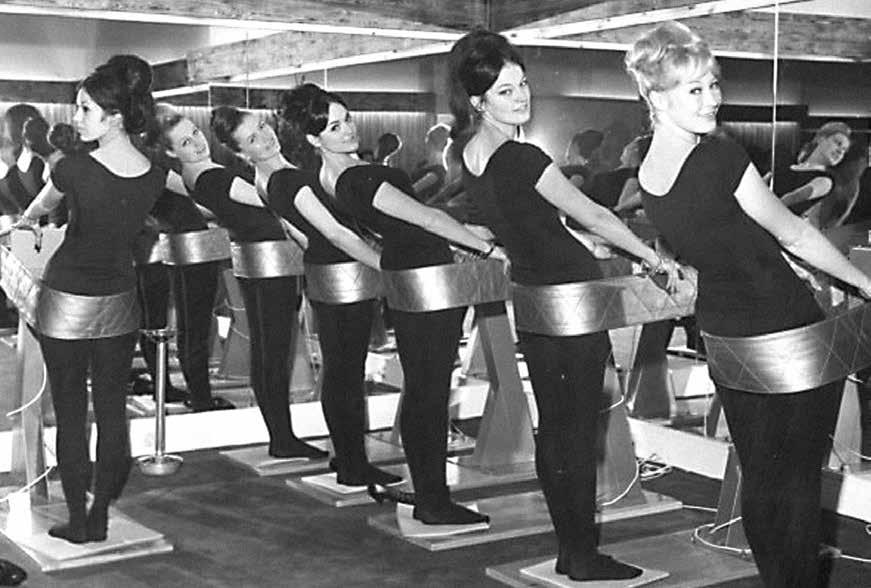
consult a personal trainer. It’s worth the investment if you are going to spend all that time working out.
2. Now that I’m exercising, it doesn’t matter what I eat. It is more important to eat properly when you begin an exercise program, as your body needs proper building blocks to re-model and create tissues.
3. If a woman lifts weights, she will get “bulky.” The hormone testosterone helps stimulate the production of new muscle tissue and determines how large your muscles will become. Women have a lower testosterone level than men, so their muscles will not enlarge as much.
4. Eating more protein will cause new muscle growth. Muscles are mainly made up of protein, but eating protein is not a stimulus to build more muscle. To stimulate muscle growth, the muscle must do work. Without the demands of physical exercise, the body has no reason to build more muscle.
5. Working the abdominals will give me a flat belly. Many people believe it’s possible to “spot reduce” fat by exercising specific parts of the body. Many exercise machines advertised on TV exploit this myth. In fact, fat is lost evenly from all parts of the body. So, getting
rid of fat on the belly requires an exercise routine that burns fat. Generally, this should include low intensity aerobic exercises and higher intensity strength exercises.
6. If it hurts, stop doing it. Although this may be true in the short term, many people never return to the activity they have enjoyed for years. Without consulting a health care professional, many assume that the pain will never go away (or they’re just getting old) and they quit. More reasonably, why not get it fixed and get back to the activity you love? Most pain is due to accumulated, repeated and painless mini-traumas. These aches and pains can be remedied reasonably quickly by massage therapists, chiropractors, physiotherapists, and athletic therapists who treat soft tissue (muscles, fascia, tendons and ligaments). Soft tissue therapists can get you back in the game.
7. I’m too old to start working out. Exercise improves physical strength, stamina, mental health and well-being. Many individuals begin exercise programs later in life—even after age 85! They find dramatic improvements in strength, coordination, balance, energy, and mental acuity. It’s never too late to begin an exercise program and it needn’t require a lot of time or effort. You can start at any level, and any increase in activity will help. If you’re currently inactive or approaching middle age, start with a visit to your doctor. Seniors can get started by contacting a personal trainer who has experience with elderly clients.
There are no limits to what you can change about your body with exercise—only misconceptions about how to do it. Change your mind about changing your body, and you’ll be amazed at what you can accomplish. —Dr. Geoff Outerbridge is a chiropractor, ergonomics consultant and personal trainer who treats occupational and sports-related musculoskeletal problems. He lives an active outdoor life in the Ottawa area. You may contact him at 521-5355.
ELEVATE YOUR FITNESS & AWAKEN YOUR MIND & BODY CONNECTION The Pilates Method OPEN
HOUSE JAN 8 & MAR 4 5:00-8:00pm • Mat classes • Reformer classes Pam Forth, BA • Individual lessons Pilates Teacher
Tel: 239-3855 315 Somerset St. W.
ACE Certified, Certified Reflexologist www.PamForthPilates.com
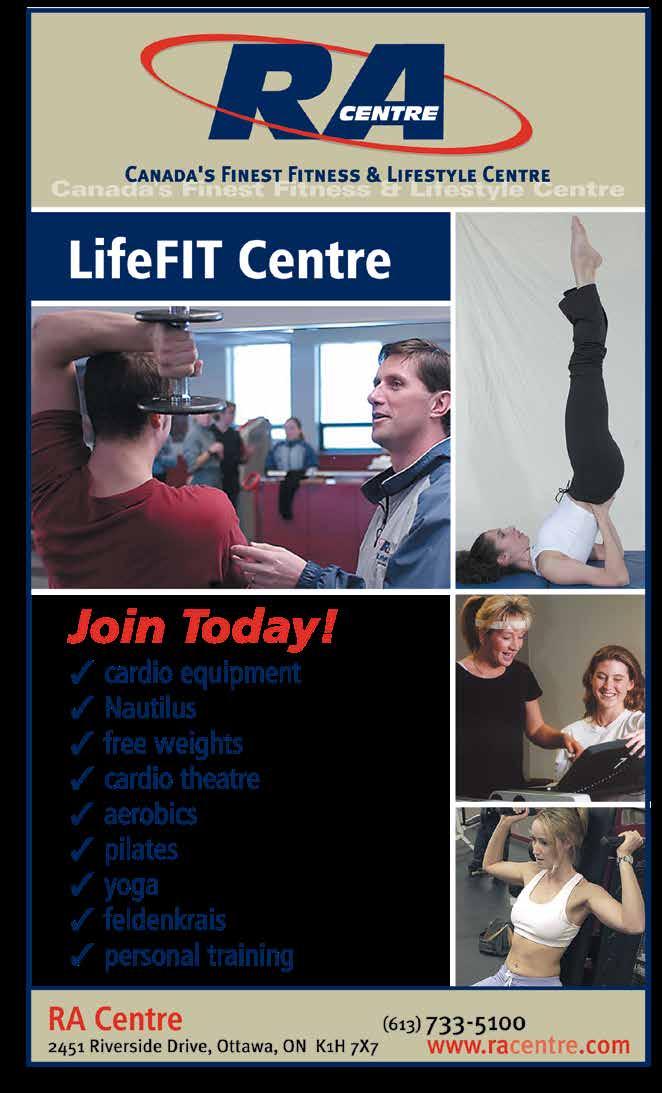
spirit body mind

NORDIC SKI
Take the “country” out of cross-country skiing Stay in the city!

By Peter McKinnon
WHEN you gotta go, you gotta go.
Many cross-country skiers in the National Capital Region think they need to travel outside the urban grid to enjoy variety of terrain and a profusion of trails. They are lured by the likes of Gatineau Park, which boasts hundreds of kilometres of the finest groomed trails this side of the Rocky Mountains. Trouble is, the 20- or 30-minute drive from Ottawa makes it tough to take to the boards on a whim.
Fortunately, our privileged existence here in The Nation’s Capital includes a wealth of great cross-country ski destinations inside the city. Let’s take a look at some of the most popular inner-city trails.
Happy trails close to home
The National Capital Commission (NCC), a federal agency mandated to beautify the capital, is the largest land owner in the region. Granted, the most famous NCC real estate lies in Gatineau Park, but there are thousands of hectares of NCC land inside the urban portion of Ottawa that are ideal for skiing. Regardless of where you live in the
city, you’re only a few minutes away from NCC greenspace.
The biggest swath of NCC land in Ottawa is the “Greenbelt,” a wide expanse of space set aside in the 1950s and ’60s to protect it from development. As a result of this policy, neighborhoods such as Blackburn Hamlet and Barrhaven are separated from urban Ottawa. The Greenbelt is a hybrid of managed forests, active farms and natural scrubland sliced up by arterial roads and all-season trails.
The NCC sells maps of the trails for $3 at InfoCapital across from Parliament Hill, or you can download a PDF version at http: //www.canadascapital.gc.ca/explore/ destinations/greenbelt/index_e.html
The NCC can’t afford to maintain or improve all of the Greenbelt, so it negotiates agreements with non-profit recreational groups that want access to parkland. There are cross-country ski clubs in Kanata and Orleans that set and maintain trails in the Greenbelt each winter.
The Kanata Cross-Country Ski Club maintains a network of trails on NCC lands near Corkstown and Hazeldean Roads, and in Stony Swamp. Recently, developers have been staking out some of these areas for housing projects, so the trails change from year to year. The club also runs a series of learn-to-ski programs under the auspices of Deena Schanzer at 592-5391 and Mike
Duivenvoorden at 591-8697. Check out the club website at http://kanataxc.tripod.com/.
In the east end, Orleans Nordic Ski Club offers learn-to-ski programs for all ages and skill levels. The contact there is Frank Roscoe at 837-7669. The club maintains more than 10 kilometres of trails through Hornet’s Nest and Mer Bleue. Most of the terrain is flat, although there are a few challenging sections, most notably up and down the toboggan hill at Green’s Creek. The Club operates a heated clubhouse at Hornet’s Nest, but you must be a member to go inside.
City of Ottawa Ski School
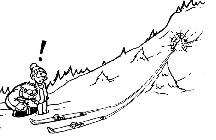
The City of Ottawa maintains a compact cross-country facility and offers courses at the Terry Fox Centre in Mooney’s Bay Park at Walkley Road and Riverside Drive. The park features five kilometres of groomed, lit trails that accommodate both classic and skate skiers. A large hill provides a challenge for even the fittest skiers. A ski pass costs $2 a day or $25 per season.
The centre also features the largest ski school in the region with more than 90 different lesson packages geared to all levels and ages. Last year, more than 700 people honed their skills at the centre. For more information, contact the aptly named
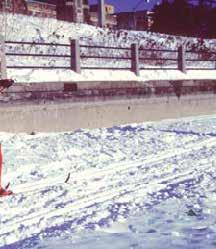
Howard Friendly at 247-4883 or visit www.ottawa.ca.
A few words of wisdom: setting and maintaining tracks is both expensive and challenging. Unfortunately, some visitors ruin trails by walking on them, rather than alongside them. Remember the cross-country skiers’ perpetual plea to those who walk the trails: “Please don’t step on our tracks!”
Break your own trail
Not all the sites I’ve listed are suitable for all types of skiing.
For instance, Mooney’s Bay is the best (and perhaps only) place to skate-ski in the National Capital outside Gatineau Park. Backcountry skiers, on the other hand, tend to head for the more remote corners of the Greenbelt in search of pristine snow. For the casual skier seeking only a reliable set of tracks, the Greenbelt trails are perfect.
The more adventurous skiers might look for a network of unofficial trails winding their way through some of the most picturesque parts of the city. Their travels might include trails along the Ottawa River, running east from the Rockcliffe boat house and west from the Western Parkway; or along the Rideau River through Vincent Massey Park at Heron Road and Riverside Drive; or through Stanley Park at River Road from Coventry Road north to Sussex Drive.
More functional and slightly less aesthetic trails run behind the Ottawa Hospital complex north of Smyth Road and along the adjacent hydro right-of-way, and through the transportation corridor near McCarthy Woods. Unfortunately, there are no trail maps for these areas yet. You need a good sense of direction, a healthy appetite for adventure, or a friend who’s been there before. The Riverview Park Community Association in Alta Vista Ward is currently defining a recreation trail for skiing and jogging throughout the vicinity (www.rpca.ca.)
Of course, there are dozens of other locations within city limits that offer interesting possibilities. To learn about trails in your area, inquire around the neighborhood, at your local community centre, or local ski equipment retail outlets.
A cross-country ski on a crisp winter’s day can be pure magic: squinting against the glint of sun on snow, savouring a deep breath of frosty air, with skis sliding effortlessly along a slippery slope. And while spectacular Gatineau Park casts its own well-deserved spell on local skiers, there is always the option to conjure up a little winter enchantment closer to home.



All the winter gear
• Alpine skis • Nordic skis • Snowboards • Snowshoes • Camping gear • Accessories • Tons more!
you’ll need!
Ottawa’s largest independent outdoor gear store!










